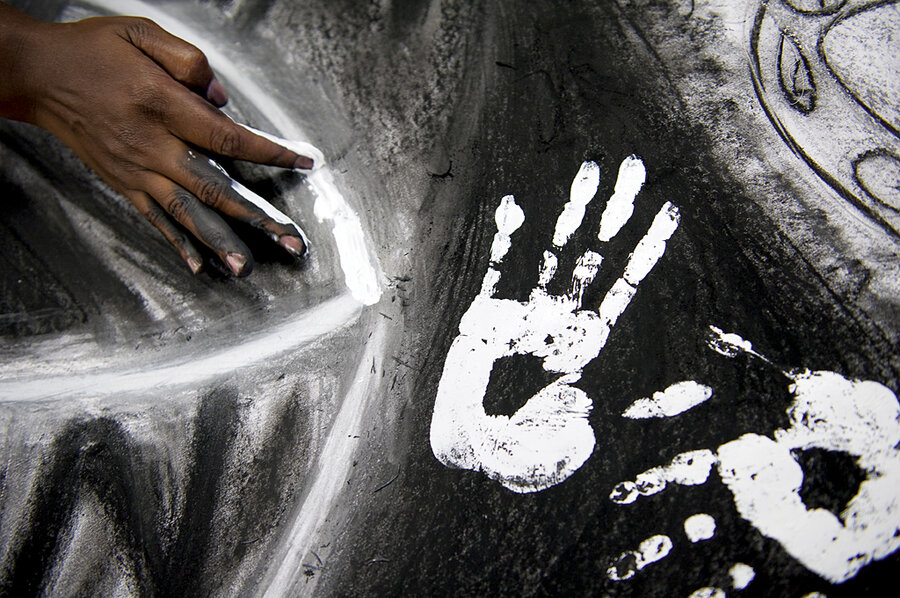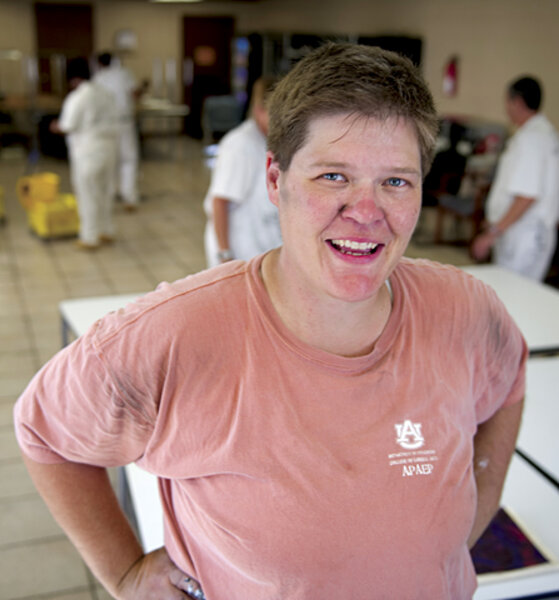Kyes Stevens and her prison arts project change women's lives
Loading...
| Montgomery and Elmore, Ala.
On a sweltering day in June, Michelle Bankston stands hunched over a table in the rec room of a minimum-security prison in Montgomery, Ala., putting the finishing touches on a charcoal drawing of an ascendant bird.
The bird, Ms. Bankston confesses, manifested itself almost accidentally – she had been drawing a maze of waves and flowers and sidelong scribbles before she noticed in the chalky whorls a head and wings.
"Sometimes it happens like that," she says with a shrug, wiping a blackened finger on her white prison-issue pants. "I'll be working on something from a dream, or I'll be envisioning things I want to do, positive things, and I'll start out with one thing, and end up with another. For me, art has always been like having a little radio playing in the back of my head."
Bankston, who has short, blond hair and a muscular build, has spent almost 20 years behind bars. She was incarcerated first at a medium-security facility here in Alabama, and then at a private prison in Louisiana (to relieve overcrowding, Alabama sends some inmates out of state), and finally here, at the Montgomery Women's Facility, a sun-soused cluster of buildings on the outskirts of the capital city.
"A while back I decided that I could either spend decades in the bunks, watching TV or playing cards," Bankston says, "or I could get out here and take the opportunity to write poetry and draw."
That she's been given this opportunity to do her art is testament to the work of Kyes Stevens, an avuncular and outspoken educator, poet, and Alabama native. Since 2002, Ms. Stevens has headed The Alabama Prison Arts + Education Project (APAEP), which offers literature and art classes in a range of prisons across the state.
The program is funded by Auburn University and an array of grants. The teaching staff consists of five Auburn-based instructors and a rotating cast of teaching fellows from the graduate creative-writing program at the University of Alabama in Tuscaloosa.
Classes run for 14 weeks and are rigorously structured, like college courses, demanding a full commitment from students.
The teachers are "people who absolutely love teaching and learning for the sake of teaching and learning," Stevens says. "It is about nothing else. It just happens that this [inside prisons] is where our students are."
Stevens grew up nearby in the small rural town of Auburn before decamping to Sarah Lawrence College in Bronxville, N.Y., where she eventually earned a master's degree in poetry.
She returned to Alabama after graduation, and spent a few months helping to renovate local homes for $10 an hour. In 2002, with the help of a friend, she received a grant to teach in a prison in Talladega, Ala.
Although the whole thing was something of a "fluke" – and although her mom worried about her, Stevens found herself exceptionally well suited to the job. She reveled in the challenge of teaching a group of prisoners whose lives and educational experiences varied so wildly. Some read and wrote ceaselessly and others hadn't finished high school. Stevens fed off the curiosity of her students.
"I loved Sarah Lawrence," she says. "It was an amazing experience. And then I got to [the] prison, and I realized I knew absolutely nothing about poetry."
In late 2002, Stevens founded the organization that would become known as APAEP; in 2004, she secured funding from the National Endowment for the Arts. That year, APAEP (cla.auburn.edu/apaep) had become an official program of Auburn University.
"It was build, build, build," Stevens says. She reached out to wardens at minimum-, medium-, and maximum-security prisons, some of whom proved more than a little skeptical. She tirelessly applied for grants and funding and recruited instructors who shared her vision and enthusiasm.
"The major reason we're able to do any of this is because of Kyes," says Ryan Browne, a longtime instructor with APEAP. "She has energy and commitment, yes, but she is also so incredibly earnest about what this program does, and [honest about] what it can do. It's always, always about the students."
Today, Stevens circles the perimeter of the rec room at the Montgomery Women's Facility, chatting with Jaime Grimes, the instructor of the class. A hard afternoon light filters through the west windows, and the assembled students – some 20 women – scrawl furiously across the wide, white paper.
Portraits of fire-breathing dragons, clouds and sunbursts, checkerboards and hearts emerge. At least one piece in its paint-splattered, controlled chaos bears a striking resemblance to a Jackson Pollock.
Mr. Grimes and Stevens stop next to Bankston. Grimes nods approvingly and suggests that Bankston try using an eraser to bring the head of the bird into relief.
"You're close," he says. "The piece looks great."
"But I'm not done," Bankston says. "I'm never totally done."
"I get that way with my poems," Stevens chortles. "I always say, 'When my art and my work are done, I'm dead.' "
"I wish we had more programs like this one," says Edward Ellington, the warden at the Montgomery Women's Facility. Programs like APAEP not only help the prisoners find a sense of self-worth – vital to preventing recidivism – but also help them make better use of their time, Mr. Ellington says.
"This is how a lot of these girls cope," he adds. "A lot of them are serving a lot of time.... If they weren't here, getting this energy out, they'd just be watching TV, playing cards, wasting time. Here, they're learning. Using their minds."
A day later, Stevens travels to Staton Correctional Facility, in Elmore, Ala., to watch a literature class led by Heather Pavletic, a doctoral candidate in English at Auburn and one of the newer APAEP instructors.
The mood in this classroom is markedly subdued, especially in comparison with the happy furor at Montgomery. Twenty-two men sit around a U-shaped configuration of tables, their hands neatly crossed, a scattering of books open before them. The air-conditioning unit gurgles.
Ms. Pavletic paces at the front of the room while Stevens looks on.
The subject of the class is "Rosencrantz & Guildenstern Are Dead," a Tom Stoppard play that famously centers on matters of free will. The title characters are trapped in a play, and a world, that seems to roar onward without their consent. The students are rapt. With each prompt from Pavletic, a dozen hands shoot up.
"I think Stoppard is saying that either way you cut it, chance or fate, we're still going to end up in the same place," says a gray-haired student named Michael Moore. "We're not writing the script, are we? We're just actors in a play."
"Maybe," answers Michael Carter, a tall, wizened prisoner, who scans a single finger over the text of the play. "But I think they can still change the world they live in. And one way for them to change the world is to change themselves. In the end it comes down to whether you are a player or a character. We have that choice, don't we?"
The class ends just after 6, and the students filter slowly out of the room, some stopping to chat briefly with Pavletic and Stevens.
"I can't get a degree with this," Mr. Moore shrugs to Stevens, "but I sure am getting a lot of perspective. It's like, I take everything in, and I get my own truths out."
After Moore has stepped away, Stevens smiles. "Invest in people, she says, "and you'd be surprised – the effects are endless."
• Sign-up to receive a weekly selection of practical and inspiring Change Agent articles by clicking here.
• To read more stories about people making a difference, click here.






